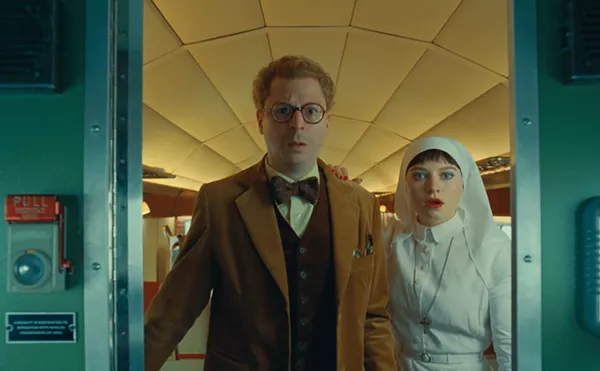I'm not much for academic theory when it comes to art -- I just don't understand the need or compulsion to explain everything to death. So I was more than a little put off when I read Joo's statement for the 1997 show "Techno-Seduction," at New York's Cooper Union School of Art, where Joo is an adjunct professor of art.
Here's the statement in its bewildering entirety: "Our demand (and capacity) for hyperextensions of our physical selves (from sports statistics to nose jobs) in search of identity is tragically ironic, yet ever increasing. In my work these extensions manifest themselves as both energy and waste producing prostheses as well as synthetic versions of my own actions and bodily by-products (urine and sweat). These analogs for the missing body (artist) represent the restriction markers used by all living things to define and identify themselves, their territory, and others. I hope to re-examine Western cultural notations of physicality (as they relate to 'process' and identity) and posit a modern social identity of the artist -- as 'producer and consumer of energy and waste. '"
Say what?
Joo seems to have mellowed, or at least returned to Planet Earth, for the PBICA show. In the tiny exhibition brochure, he says more comprehensible things like "Process is more important than image to me" and "Materials in my work can range from synthetic sweat or loaded handguns to salt or cast plastic. I have used chemically grown crystals, chia plants, monosodium glutamate (MSG), and even bronze. It is usually whatever I feel is necessary for the work itself." And in the introduction posted at the show's beginning, Joo is quoted as saying, "I am interested in playing with notions of physicality and the slippery nature of the identity of an object (or person, place, thing)."
OK, now we're getting somewhere. Let's leave aside for the moment the question of exactly what "synthetic sweat" is (another piece incorporates "synthetic tears"), along with Joo's seeming surprise to find himself working with "even bronze," as if this most enduring medium were hopelessly quaint. At least he has provided us with a few clues about his concerns as an artist and his media of choice without veering wildly off into theory.
That leaves us to explore the art itself, and that's where the other half of my ambivalent reaction to Joo comes in. Stripped of all art-babble, Joo's work, though essentially conceptual, often has an amazing visceral impact. And that's "visceral" both in terms of the viewer's reaction to it and in terms of the subject matter, and sometimes even the actual content, of the art.
In this first American survey of Joo's output, all created within the past decade, humans and animals are at the heart of much of his most powerful pieces. He's among a new breed of artists who combine nature and science in ways that are sometimes disturbing and almost always provocative. In Caribou Taxidermy (2003), for example, a fully preserved caribou hangs from wires positioned on its side, with three video cameras and corresponding monitors positioned at different points around the animal, so that you can see yourself examining the creature from various vantage points. You can even stick your head inside the gutted carcass, and I'd have to describe the scent not as that of death but that of life frozen in time.
It's not surprising to learn that Joo is linked with the famous (some would say infamous) young British artist Damien Hirst, known for displaying similarly preserved animals in tanks filled with various chemical solutions. Indeed, Joo's caribou and a couple of other pieces are on loan to the exhibition courtesy of Hirst, who gave Joo a big boost when he included him in the 1994 show "Some Went Mad, Some Ran Away" at the Serpentine Gallery in London.
For Hunt (Balance for Left and Right Lobes) (1993-94), Joo works with elk antlers cast in resin. The antlers are halved and attached to the ends of a long, arcing Plexiglas tube with some sort of crest in the center mounted on the wall. Among the ingredients listed are urethane, engraved aluminum, mercury, bleach, hydrochloric acid, simethicone, and glass. Improved Rack #1 (Moose) (1999) extends a set of moose antlers by adding stainless steel inserts so that the form becomes larger and somehow much more majestic.
Humans aren't spared Joo's scientific tinkering. Visible (1999-2000) features a headless, transparent figure seated in a Buddhaesque pose on a walnut platform, its artificially re-created innards visible from all sides. Again, the ingredients sound as if they came from an industrial laboratory: urethane, nylon, plastic, steel, glass, and patinated steel.
My choice for Joo's most imposing piece in this survey of 50 to 60 works is God II (2003). It rests on a blocky Plexiglas base with a refrigeration unit on top and one vented side that expels chilled air. Sprawled on his back atop this base is a lifesize figure of what looks to be an Eskimo man, wearing boots, pants, and a hooded shirt or jacket trimmed with fur. The man, however, is made of clear cast urethane over a skeleton made of polyethylene plastic. Is he meant to be dead or alive? There's no way of knowing. The piece is also interactive in a way: If you lean in to examine the body, the moisture in your breath condenses and then adds to the layer of ice upon which the man rests.
Joo displays a lighter side in a few pieces. The wall-mounted Chia (1999) consists of a pair of adjoining glass panels sitting on a slab of kiln-fired terracotta, with two little strips of live salvia columbariae (presumably the stuff of which chia creatures are made). Access/Denial (2002), at the juncture of the museum's main gallery and the small, narrow gallery alongside it, is a blink-and-you'll-walk-by-it piece that's nothing more than a pair of stainless steel stanchions with a cast urethane rope strung between them -- those things used to keep ordinary people out of grand openings and trendy clubs and the like, while letting celebrities and their ilk in. The joke is that there's nowhere to go behind the rope.
The artist outdoes himself with Yellow, Yellower, Yellowest (1991). On an engraved aluminum shelf sit three glass beakers, each filled with urine and each labeled to identify the contributors: Genghis Khan, Benedict Arnold, and Michael Joo. The sick metaphysical joke begins with the obvious fact that at least two of the beakers are misidentified, then moves on to make us wonder whether the Joo beaker actually contains the artist's own piss. Is it even real urine, given the artist's penchant for using "synthetic" bodily fluids? The list of ingredients indicates that the beakers also contain preservative, but there's also mold floating on the surface of the liquid. Again, illusion or reality?
It's too soon to tell where the obvious talents of Joo, a second-generation Korean-American born in Ithaca, New York, in 1966, will take him. His higher education began with a bachelor's in biology from Wesleyan University, and what he picked up there has been well integrated into his continued studies that culminated in a BFA in sculpture from Washington University and an MFA from the Yale School of Art. Along with his Damien Hirst connection, he has already achieved such lofty accolades as inclusion in the 2001 Venice Art Biennial, where he represented his parents' native Korea.
But there's a curiously incomplete feeling to some of Joo's work that suggests he may not yet have fully discovered his artistic voice. It's almost as if he abandoned some of his pieces at some point along the way and, wittingly or not, never went back. I don't mean to say he's one of those "art is whatever you want it to be" people who just create the work and send it out into the world, but I do think he wants viewers to engage each piece on both its and their own terms. That makes him a perfect artist for PBICA, which continues to champion risk-taking art.







